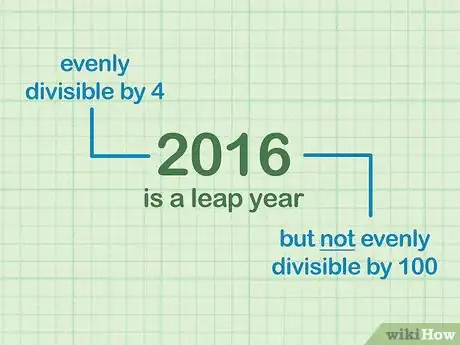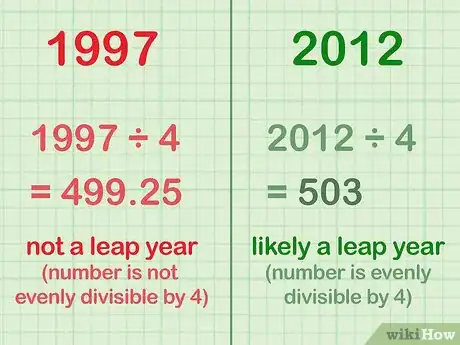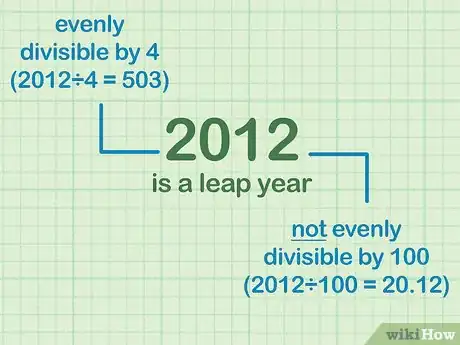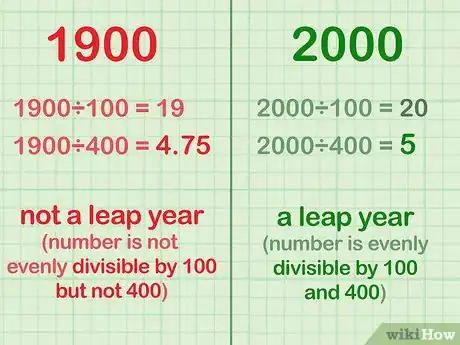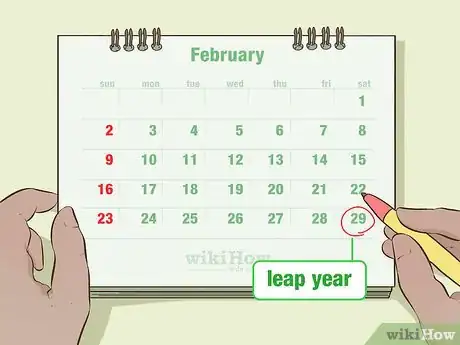This article was co-authored by wikiHow Staff. Our trained team of editors and researchers validate articles for accuracy and comprehensiveness. wikiHow's Content Management Team carefully monitors the work from our editorial staff to ensure that each article is backed by trusted research and meets our high quality standards.
wikiHow marks an article as reader-approved once it receives enough positive feedback. In this case, several readers have written to tell us that this article was helpful to them, earning it our reader-approved status.
This article has been viewed 644,264 times.
Learn more...
Leap years are a way to ensure that our calendar is on track. There are roughly 365.24 days in a year, which means that we need to add 1 extra day once every 4 years, and a year with 1 extra day is known as a leap year. We need to do this to ensure that we don't fall several hours behind each year. Calculating leap years is easy, but there are a few special rules to keep in mind as you do your calculations. If you prefer to look at a calendar instead of doing the math, then this is also an option.
Steps
Using Division
-
1Identify the year you want to check. Calculating leap years requires having a year that you want to check. Use a past year, the current year, or a future year as your starting point.[1]
- For example, you could start by checking 1997 or 2012 if you want to look at a past year, or go with 2019 to check the current year, or select 2025 or 2028 to check a future year.
-
2See if the number is evenly divisible by 4. Dividing the year by 4 will result in a whole number with no remainder if the number is evenly divisible. The number must be evenly divisible by 4! Otherwise, it is not a leap year.[2]
- For example, dividing 1997 by 4 gives you 499.25, which is not a whole number because it ends with a decimal. Therefore, it is not a leap year.
- When you divide 2012 by 4, you get 503, which is a whole number. This means that 2012 is likely a leap year.
Advertisement -
3Confirm the number isn't evenly divisible by 100. If a year is evenly divisible by 4, but it is not evenly divisible 100, then it is a leap year. If a year is divisible by both 4 and 100, then it might not be a leap year, and you will have to perform 1 more calculation to check.[3]
- For example, 2012 is evenly divisible by 4, but not 100 since it results in a decimal answer (20.12). This means that 2012 is definitely a leap year.
- 2000 is divisible by 4 and it is also evenly divisible by 100 since it leaves a result of 20. That means that 2000 might not be a leap year and you will have to divide it 1 more time.
-
4Check if the number is evenly divisible by 400 to confirm a leap year. If a year is divisible by 100, but not 400, then it is not a leap year. If a year is divisible by both 100 and 400, then it is a leap year.[4]
- For example, 1900 is evenly divisible by 100, but not 400 since it gives you a result of 4.75. This means that 1900 is not a leap year.
- On the other hand, 2000 is evenly divisible by 100 and 400, since it gives you a result of 5. That means that the year 2000 is a leap year.
Tip: If you don’t want to manually divide a number to check it, or if you are unsure of your results, use an online leap year calculator. This will do the calculations for you.[5]
Checking a Calendar
-
1Locate the year you want to know about in a calendar.[6] Start by identifying the year that you want to check and then get out a physical calendar or open an online calendar to check that year. If you are using an online calendar, then you should be able to look back or ahead by at least a few years.[7]
- For example, if you want to see if 2016 was a leap year, go back to that year’s calendar.
- If you want to check if 2021 is a leap year, go to that year online.
-
2Turn to February and see if there is a 29th day. Leap years always result in 1 extra day that is placed at the end of February, since this is the shortest month in the year. Turn to that month in the calendar and check to see if there is a February 29th listed. If there is, then it is a leap year.[8]
- If February only goes through the 28th, then it is not a leap year.
-
3Expect another leap year in 4 years. Each year lasts about 365 days and slightly under 6 hours. That extra 6 hours adds up to an extra day over the course of 4 years, which is why leap years occur almost every 4 years. Count ahead 4 years from the last leap year to estimate when the next leap year will be.[9]
- For example, since 2016 was a leap year, you could count ahead 4 years to 2020 as a way to predict the next leap year.
Tip: Keep in mind that sometimes there won’t be a leap year for 8 years since there is a little less than 6 extra hours each year—5 hours, 48 minutes, and 46 seconds to be exact.[10] That is why it is helpful to do calculations instead of relying on a leap year every 4 years.
Community Q&A
-
QuestionWhy do we check for divisibility by 100? Is it not enough to check divisibility by 4?
 Community AnswerNo, there is still a small error that must be accounted for. To eliminate this error, the Gregorian calendar stipulates that a year that is evenly divisible by 100 (for example, 1900) is a leap year only if it is also evenly divisible by 400. For this reason, the following years are not leap years: 1700, 1800, 1900, 2100, 2200, 2300, 2500, 2600. This is because they are evenly divisible by 100 but not by 400.
Community AnswerNo, there is still a small error that must be accounted for. To eliminate this error, the Gregorian calendar stipulates that a year that is evenly divisible by 100 (for example, 1900) is a leap year only if it is also evenly divisible by 400. For this reason, the following years are not leap years: 1700, 1800, 1900, 2100, 2200, 2300, 2500, 2600. This is because they are evenly divisible by 100 but not by 400. -
QuestionWhy do we have leap years?
 Community AnswerEach year is technically 12 months and a fraction of a day, close to .25. Every four years, the fraction is compiled to create a whole day and added to that year.
Community AnswerEach year is technically 12 months and a fraction of a day, close to .25. Every four years, the fraction is compiled to create a whole day and added to that year. -
QuestionWhy specifically divided by 4, 100, and 400?
 Community AnswerThese numbers resulted from complex calculations that were done to ensure that, over the long term, our calendar years would stay as close as possible to the actual time it takes the earth to revolve around the sun. This includes somewhat arbitrary additions/subtractions of an extra day to certain years. Generally speaking, leap years occur every 4 years, and they are the years divisible by 4 (2000, 2004, 2008, etc.). However, for three out of four years divisible by 100, the leap year thing is skipped; only those years divisible by 100 that are also divisible by 400 remain leap years (so: 1600 was a leap year, while 1700, 1800, and 1900 were not; 2000 was a leap year, while 2100, 2200, and 2300 will not be).
Community AnswerThese numbers resulted from complex calculations that were done to ensure that, over the long term, our calendar years would stay as close as possible to the actual time it takes the earth to revolve around the sun. This includes somewhat arbitrary additions/subtractions of an extra day to certain years. Generally speaking, leap years occur every 4 years, and they are the years divisible by 4 (2000, 2004, 2008, etc.). However, for three out of four years divisible by 100, the leap year thing is skipped; only those years divisible by 100 that are also divisible by 400 remain leap years (so: 1600 was a leap year, while 1700, 1800, and 1900 were not; 2000 was a leap year, while 2100, 2200, and 2300 will not be).
References
- ↑ https://www.mathsisfun.com/leap-years.html
- ↑ https://www.mathsisfun.com/leap-years.html
- ↑ https://www.mathsisfun.com/leap-years.html
- ↑ https://www.mathsisfun.com/leap-years.html
- ↑ http://www.onlineconversion.com/leapyear.htm
- ↑ https://dinotracksdiscovery.org/static/ancillary/lessons/pdfs/calculating-leap-year.pdf
- ↑ https://www.timeanddate.com/date/leapyear.html
- ↑ https://www.timeanddate.com/date/leapyear.html
- ↑ https://www.mathsisfun.com/leap-years.html
About This Article
To calculate whether or not a year is a leap year, start by checking if the number is evenly divisible by 4 since leap years need to be. Then, if it is evenly divisible by 4, check to see if it's evenly divisible by 100. If it's not, then it's a leap year. However, if it is evenly divisible by both 100 and 4, it might still be a leap year. To check, see if the year is evenly divisible by 400. If it is, then it's a leap year. To learn how to check to see if a year is a leap year using a calendar, scroll down!
